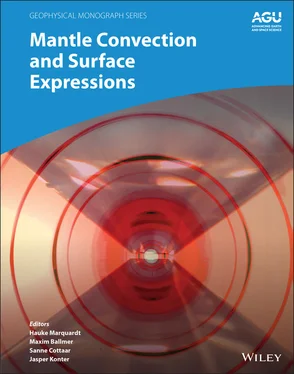When large enough crystal specimens are available, sound wave velocities can be derived by measuring the travel time of ultrasonic waves through single crystals. Initially developed for centimeter‐sized samples and using frequencies in the megahertz range (e.g., Spetzler, 1970), this technique can be adopted to micrometer‐sized samples contained in DACs by raising the frequencies of ultrasonic waves into the gigahertz range (Bassett et al., 2000; Reichmann et al., 1998; Spetzler et al., 1996). While first ultrasonic experiments in DACs were restricted to P‐ wave velocity measurements, Jacobsen et al. (2004, 2002) designed P ‐to‐ S wave converters to generate S waves with frequencies up to about 2 GHz and to enable the measurement of S‐ wave velocities on thin single crystals in DACs up to pressures of about 10 GPa (Jacobsen et al., 2004; Reichmann and Jacobsen, 2004). The relatively young techniques of picosecond acoustics and phonon imaging use ultrashort laser pulses to excite sound waves and to measure their travel times on the order of several hundred picoseconds, allowing to further reduce sample thickness. These techniques have been implemented with DACs to study elastic properties at high pressures and bear the potential to derive full elastic stiffness tensors (Decremps et al., 2014, 2010, 2008). At ambient pressure, the ultrasonic resonance frequencies of a specimen with a well‐defined shape can be measured as a function of temperature and then be inverted for the elastic properties (Schreuer & Haussühl, 2005). The technique of resonant ultrasound spectroscopy (RUS) has been used, for example, to trace the elastic stiffness tensors of olivine single crystals up to temperatures relevant for the upper mantle (Isaak, 1992; Isaak et al., 1989).
The elastic response of a perfectly isotropic polycrystalline aggregate is, in principle, fully captured by the isotropic bulk and shear moduli. These moduli can be determined from the velocities of sound waves propagating in any direction through an isotropic polycrystal. Consequently, the elastic properties of many minerals have been studied on polycrystalline samples or powders, especially when single crystals of suitable size and quality were not available. Elastic moduli determined on polycrystalline samples, however, do not allow computing absolute bounds on the elastic response nor can they capture the elastic anisotropy of the individual crystals that compose the polycrystal. Polycrystalline samples need to be thoroughly characterized to exclude bias by an undetected CPO or by small amounts of secondary phases that might have segregated along grain boundaries during sample synthesis or sintering. Microcracks or vanishingly small fractions of porosity might also alter the overall elastic response of a polycrystal (Gwanmesia et al., 1990; Speziale et al., 2014).
Millimeter‐sized polycrystalline samples can be compressed and heated in multi‐anvil presses while the travel times of ultrasonic waves through the sample are being measured by an interference technique (Li et al., 2004; Li and Liebermann, 2014). When the experiment is conducted at a synchrotron X‐ray source, the sample length can be monitored by X‐ray radiography, which requires the intense X‐rays generated by the synchrotron. Otherwise the sample length can be inferred from an equation of state or solved for iteratively. Sound wave velocities can then be calculated from combinations of travel times and sample length. The stability of modern multi‐anvil presses facilitates sound wave velocity measurements on samples held at pressures and temperatures that exceed those of the transition zone in Earth’s mantle (Gréaux et al., 2019, 2016). By combining sample synthesis and ultrasonic interferometry in the same experiment, Gréaux et al. (2019) and Thomson et al. (2019) were able to determine the sound wave velocities of the unquenchable cubic polymorph of calcium silicate perovskite, CaSiO 3. After synthesis at high pressure and high temperature, cubic calcium silicate perovskite cannot be recovered at ambient conditions as its crystal structure instantaneously distorts from cubic to tetragonal symmetry below a threshold temperature (Shim et al., 2002; Stixrude et al., 2007). A similar situation is encountered for stishovite, SiO 2, which reversibly distorts from tetragonal to orthorhombic symmetry upon compression (Andrault et al., 1998; Karki et al., 1997b). Such displacive phase transitions can substantially change the elastic properties of materials and illustrate the need to determine elastic properties at relevant pressures and temperatures.
The wavelengths of sound waves used to derive the elastic moduli may also affect how the elastic properties of individual grains in a polycrystalline material are averaged by the measurement. At ultrasonic frequencies, sound waves travel with wavelengths between 10 μm and 10 mm that are long enough to probe the collective elastic response of fine‐grained polycrystalline samples. Sound waves probed by light scattering techniques, however, typically have wavelengths on the order of 100 nm to 10 μm (Cummins & Schoen, 1972; Fayer, 1982), which is similar to typical grain sizes in polycrystalline samples. When the wavelength is similar to or smaller than the grain size, the measured sound wave velocity may be dominated by the elastic response of individual crystals or of the assembly of only a few crystals. When light is scattered by these single‐ or oligo‐crystal sound waves, the measurement on a polycrystal takes an average over sound wave velocities within single crystals rather than averaging over the elastic properties of a sufficiently large collection of randomly oriented crystals that determine the aggregate sound wave velocities at longer wavelengths. The intensity of the scattered light also depends on the orientations of the individual crystals via the photoelastic coupling that can enhance light scattering for some orientations and emphasize their sound wave velocities over others (Marquardt et al., 2009a; Speziale et al., 2014). Nevertheless, light scattering experiments on polycrystalline samples have contributed substantially in characterizing the elastic properties of mantle minerals at high pressures (Fu et al., 2018; Murakami et al., 2009b) and at high pressures and high temperatures (Murakami et al., 2012).
Synchrotron X‐rays can be used to probe the lattice vibrations of crystalline materials. Inelastic X‐ray scattering (IXS) combines the scattering geometry of the X‐ray–lattice momentum transfer with measurements of minute energy shifts in scattered X‐rays that result from interactions with collective thermal motions of atoms in a crystalline material (Burkel, 2000). At low vibrational frequencies, these collective motions are called acoustic phonons and resemble sound waves. Their velocities can be derived from an IXS experiment by setting the scattering geometry to sample acoustic phonons that propagate along a defined direction and with a defined wavelength and calculating their frequencies from the measured energy shifts of inelastically scattered X‐rays. The energy distribution of lattice vibrations, the phonon density of states, can be studied by exciting the atomic nuclei of suitable isotopes and counting the reemitted X‐rays (Sturhahn, 2004). Because the atomic nuclei are coupled to lattice vibrations, a small fraction of them absorbs X‐rays at energies that are modulated away from the nuclear resonant energy reflecting the energy distribution of phonons that involve motions of the resonant isotope. 57Fe is by far the most important isotope in geophysical applications of nuclear resonant inelastic X‐ray scattering (NRIXS). Both IXS and NRIXS can be performed on samples compressed in diamond anvil cells to constrain the elastic properties of single crystals or polycrystalline materials (Fiquet et al., 2004; Sturhahn & Jackson, 2007). Given the low efficiency of inelastic X‐ray scattering in general and the selective sensitivity of NRIXS to Mössbauer‐active isotopes such as 57Fe, many IXS and NRIXS studies focused on iron‐bearing materials, including potential alloys of Earth’s core (Antonangeli et al., 2012; Badro et al., 2007; Fiquet et al., 2001) and minerals relevant to Earth’s lower mantle (Antonangeli et al., 2011; Finkelstein et al., 2018; Lin et al., 2006; Wicks et al., 2017, 2010).
Читать дальше












